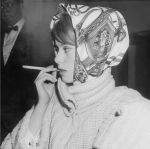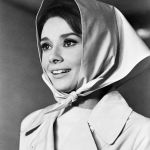
History of the headscarf as an accessory
From Audrey Hepburn to Billie Eilish, celebrities are obsessed with Old Hollywood-style headscarves
November 22nd, 2023
Balaclava? Warm woolen beanies? Headbands a la Brigitte Bardot? No. Or rather, not only. The unexpected celebrity obsession for autumn/winter 2023 is a delicate silk handkerchief knotted under the chin, just like in films and photos of old Hollywood divas. From Audrey Hepburn to Kendall Jenner, from Jackie Kennedy to Billie Eilish - everyone is fascinated by this piece of fabric, which is more versatile than any other item of clothing and takes on different stylistic characteristics and socio-cultural meanings depending on the era, tradition and wearer. Filtered through pop culture and personal memories, the headscarf as a hair ornament evokes an overlap of contrasting images and moods that combine with a fashionable file rouge Queen Elizabeth and Lily Collins in Emily in Paris, an old-fashioned grandmother and Julia Fox on the streets of New York, stars driving around in convertibles with the handkerchief flapping in the wind, and Carrie Bradshaw in And Just Like That, with the knotted babushka-style carré to protect her hair from the smell of cigarettes.
The thousand lives of the headscarf, between utility, religion and rebellion
The headscarf, or a kind of cloth veil on the head, has been worn for thousands of years and in just as many different cultures. It serves as protection for the hair and as a symbol of religious affiliation, social status or marital status. When women cover their hair, they are - often unconsciously - continuing a centuries-old tradition with a polarising history in which utility, religion, rebellion and fashion are interwoven. According to Sonnet Stanfil, curator of fashion at the Victoria and Albert Museum, covering the hair was seen as a sign of a straightforward life - an attitude that ran through the Judeo-Christian tradition and has been passed down through Hollywood hedonism to the present day. In Mesopotamian societies, which used this piece of cloth to protect the head from rain and sun, it was originally a necessity, but soon became attributed to religion, which helped to enforce the idea that wearing hair equated to being a respectable person. Even today, the head covering with a kind of veil is still part of the wardrobe of Catholic nuns, women of the Islamic faith and married Orthodox Jewish women who wear the tichel (or sheitel). Even if we are talking specifically about the headscarf, the origins and development do not differ significantly. The earliest evidence of the use of the headscarf dates back to 1000 BC and Eastern civilisations, while the earliest finds in Western history can be dated to the second century AD. Here, the headscarf was initially worn for practical reasons to protect against the elements, both in the military and in the countryside. In 1900, the headscarf as we know it today was born as a multifunctional, practical and chic accessory. In the 1920s, flapper girls tied printed silk scarves around their heads to dance and drive; in the 1940s, Rosie the Riveter in the poster "We Can Do It" and other women of her time tied a polka-dotted headscarf around their hair, adding a touch of femininity even when working in factories; in the 1960s, the headscarf was a glamour staple for divas like Grace Kelly and Jackie Kenney; in the following decade, it was popular with hippies in colourful and cheerful prints, while in the 1990s it was worn as a bandana or headband by hip-hop and R&B stars like Aaliyah, Jennifer Lopez and Destiny's Child.
Hermès and the headscarf in fashion
In the early 1900s, chic fashion designers such as the Frenchman Paul Poiret designed scarves with eye-catching patterns for the emancipated women of the time, which they wore as sophisticated shawls or wrapped loosely around the forehead in a rather unconventional style. However, scarf trend exploded a few years later when Hermès launched its first carré in 1937, called Jeau des Omnibus et Dames Blanches, which illustrated the inauguration of the Madeleine Bastille public transport system. Thus was born the most iconic silk twill accessory, a must in the wardrobe of every elegant lady. The women who used the precious garment (but also many of its cheaper duplicates) to conceal their curlers, which were essential for their updos when they left the house, made it a style staple. But the divas of the 1950s and 1960s in particular wore it at every opportunity. Since then, the head scarf has returned cyclically among the offerings of many brands, from Dior to Jacquemus, Versace to Bora Aksu.
One, no, a hundred thousand ways to wear it
The scarf is still very popular today due to its extreme versatility. As millions of videos on TikTok show, there are many different ways to wear it. A couple? Knotted around the neck, used as a belt, displayed on the wrist like a bracelet, attached to a handbag, left loose and dangling over one or both shoulders, but mostly as a hair accessory that remains contemporary. It can be alternated with strands to create a more special braid, used as a clip for a ponytail, worn as a Pirates of the Caribbean style bandana, or made into a "Kelly" where the bandana is wrapped over the head attached to the neck and then knotted at the back. The current trend style? The “Babushka”," simply tied under the chin.
The headscarf in 2023
Celebrities such as Kendall Jenner, Billie Eilish and Dua Lipa are celebrating the comeback of the headscarf knotted under the chin in 2023. The role model is Audrey Hepburn, a timeless style icon whose classic looks on and off the screen often included the scarf, even when she married Italian psychiatrist Andrea Dotti. Billie Eilish, for example, uses it to elevate her streetwear style by playing with monogram prints, retro polka dots or plain colours, giving her tomboy aesthetic an interesting contrasting twist. Kendall Jenner, on the other hand, ties them either under her chin or behind her head to add a snazzy twist to her calm luxury looks, while Dua Lipa was one of the first to use them as a winter accessory in a snowy snap from January 2022.



































































































